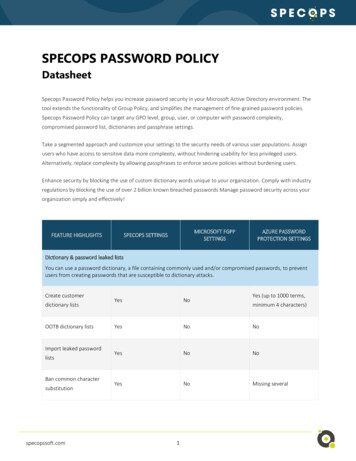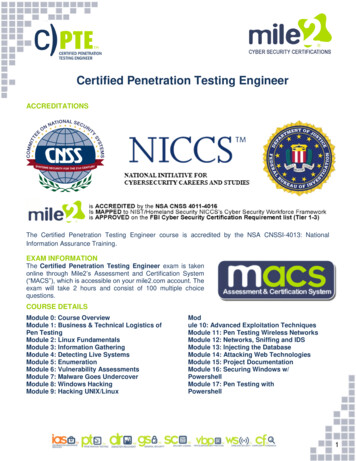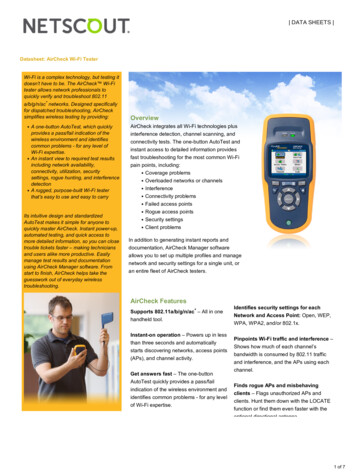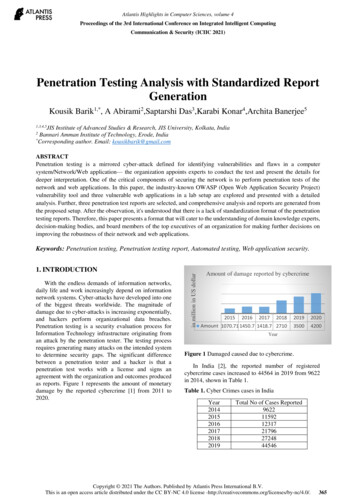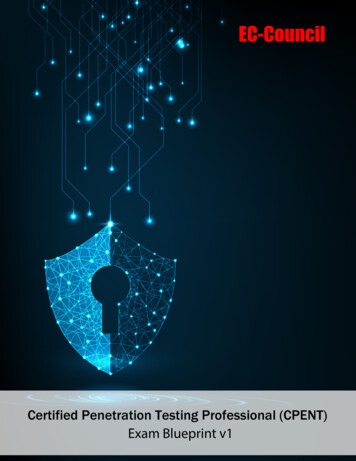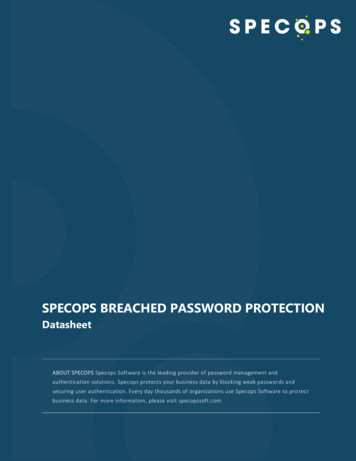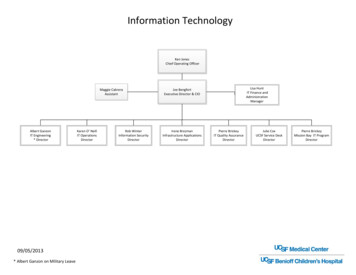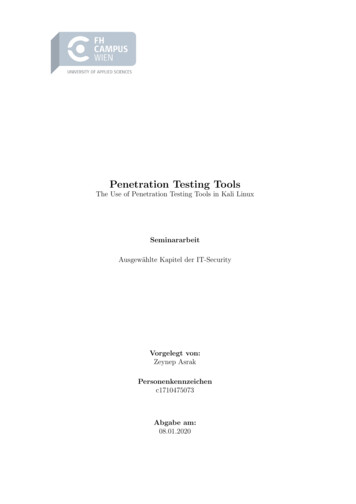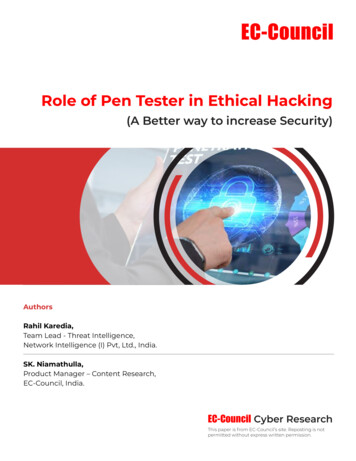
Transcription
Penetration Tester toSpecOps EngineerSKILLSOFT ASPIRE JOURNEY
PrerequisitesWe recommend the following prerequisite skills: Familiar with Penetration TestingFamiliar with Ethical Hacking
Objectives:Penetration TestingFundamentals describe what penetration testing is and why it is important to the organizationdescribe the common types of penetration and the importance of testing each typedescribe passive information gathering and methods for collecting informationdescribe active information gathering along with methods and techniques for collectinginformationcompare vulnerability to penetration testing and describe the function of eachdescribe the cause of buffer overflow and how this exploit can be used for attacksdescribe user privilege escalation and methods that can be used to protect your systemfrom security attacksdescribe common client-side attacks such as Cross-Site Scripting attacks and methods tohelp prevent themdescribe common web cyberattacks and countermeasures to prevent these attacksdescribe common password attacks and methods for preventing themdescribe port forwarding and how it can be used as an exploitdescribe the purpose of network tunneling and why it is important for penetration testingObjectives:Pen TestingAwareness: ResultsManagement describe how to set expectations and why it is importantdescribe black box penetration testing and why it may be useddescribe white box penetration testing and why it may be useddescribe grey box penetration testing and why it may be useddescribe the rules of engagement and how they are useddescribe the importance of setting stopping points and when to stop a penetration testdescribe what should be documented during a penetration test and why it is importantdescribe the different categories of findingsdescribe organizational risk tolerance and why it is importantdescribe the importance of aligning recommendations to corporate culture, policies, andprocedures describe how to communicate changes to lay persons and executives describe the importance of working with management to conduct further testing afterrecommendations are implemented
Objectives:Security Measures:ImplementingSecurity Controls describe security controls in relation to the overall NIST Cybersecurity Framework andhow security controls are relevant in SecOps describe the major security control types and the components of a security control describe various areas where security controls are commonly used describe defensive and quick win controls for the major control types, how they arecompromised, and steps for root cause analysis describe the CIS critical security controls and how they are implemented describe when to use security controls and how they are enforced describe various complex security controls and how they are implemented, includingindustrial and government security controls and baselines describe various controls for assessment and monitoring describe how to assess security controls, including establishing security metrics for riskmanagement framework and reporting investigate security controls when one fails and describe how to mitigate the outcome describe processes of auditing security controls, including how to conduct an audit oncontrol policies describe potential risk scenarios and how to mitigate and respond using security controls,including how to test the controls to effectively respondObjectives:Pen Testing: Enduser Behavior identify penetration testing types and describe their reliance on end-user behaviordescribe the limitations of penetration testing and challenges for organizationsidentify the role of human error in causing data breachesdescribe the role of end-user awareness in preventing cybersecurity attacks andduring penetration testingdescribe user behavior analytics and why it is important during penetration testingidentify tools for performing user behavior analyticsidentify how to translate penetration testing results into a formalized report that canbe used for the end-user awareness programrecognize social engineering attacks and how to they relate to penetration testingdescribe how to perform social engineering penetration testingdescribe the goals of social engineering penetration testsdescribe tips and tricks for preventing social engineering attacksdescribe the role of human behavior in penetration testing
Objectives:PhysicalPenetration Testing describe the importance of physical penetration testing and why organizations mustperform penetration testing describe the steps necessary to implement a physical penetration testing program and thephases of penetration testing identify different lock pick tools and why lock picking is important in cybersecurity describe how to protect sensitive data with security testing and the five penetrationtesting rules of engagement describe penetration testing tools that are used by professional hackers identify the types of penetration testing and common terminology describe electromagnetic security vulnerabilities and devices that can help prevent thismethod of attack describe the purpose and results of dumpster diving and how to protect against this formof attack identify how to recognize and prevent tailgating and recognize the risks that it exposes describe how to document the findings of physical penetration testing and the keycomponents of the report identify web application security testing methodologies and the five stages of OPSEC perform penetration testing using the Gruyere demo web siteObjectives:Wi-Fi PenetrationTesting identify the business need to provide Wi-Fi access for internal employees and externalpartners and recognize the categories of wireless threats that can compromise networks recognize the built in sniffing capabilities of Wi-Fi used for penetration testing step through the process to perform rough AP analysis identify the vulnerabilities and processes used to undermine an unsecured Wi-Fi hotspot describe the processes used to undermine a Wi-Fi client's vulnerabilities list the vulnerabilities of WEP security and identify how they can be exploited outline the steps used to perform a Denial of Service attack against a wireless network describe the technique of Wi-Fi fuzzing as a method to discover bugs over a wirelessnetwork list the vulnerabilities of WPA pre-shared key security and identify how they can beexploited identify best practices for taking Wi-Fi pen testing results and integrating them intosecurity protocols and end-user education programsObjectives:Advanced PenTesting Techniques describe how to find a vulnerability using scanners and other techniques capture and analyze network traffic using Wireshark recognize wireless security technologies such as WEP, WPA/2/3, and the vulnerabilitiesthey have that could be exploited describe cryptography and its four goals differentiate between symmetric and asymmetric cryptography recognize how to choose a password cracking technique differentiate between malware types and recognize some of the consequences of usingtargeted malware differentiate between scanning and enumeration recognize the benefits of using Python to build scripts and deliver exploits perform Linux privilege escalation via writeable /etc/passwd file perform Windows privilege escalation to exploit a Windows system using theAlwaysInstallElevated technique use PowerShell to perform pen testing tasks such as reporting on all USB devices installed,killing processes, and using PSDrive to view objects in Windows
Objectives:Final Exam:Penetration Tester capture and analyze network traffic using Wireshark compare vulnerability to penetration testing and describe the function of each describe active information gathering along with methods and techniques for collectinginformation describe black box penetration testing and why it may be used describe common client-side attacks such as Cross-Site Scripting attacks and methods tohelp prevent them describe common web cyber attacks and countermeasures to prevent these attacks describe cryptography and its four goals describe defensive and quick win controls for the major control types, how they arecompromised, and steps for root cause analysis describe grey box penetration testing and why it may be used describe how to assess security controls, including establishing security metrics for riskmanagement framework and reporting describe how to find a vulnerability using scanners and other techniques describe how to perform social engineering penetration testing describe how to protect sensitive data with security testing and the five penetrationtesting rules of engagement describe how to set expectations and why it is important describe passive information gathering and methods for collecting information describe penetration testing tools that are used by professional hackers describe security controls in relation to the overall NIST Cybersecurity Framework andhow security controls are relevant in SecOps describe the cause of buffer overflow and how this exploit can be used for attacks describe the CIS critical security controls and how they are implemented describe the common types of penetration and the importance of testing each type describe the different categories of findings describe the goals of social engineering penetration tests describe the importance of physical penetration testing and why organizations mustperform penetration testing describe the importance of setting stopping points and when to stop a penetration test describe the importance of working with management to conduct further testing afterrecommendations are implemented describe the limitations of penetration testing and challenges for organizations describe the major security control types and the components of a security control describe the processes used to undermine a Wi-Fi client's vulnerabilities describe the purpose and results of dumpster diving and how to protect against this formof attack describe the role of end-user awareness in preventing cybersecurity attacks and duringpenetration testing describe the rules of engagement and how they are used describe the steps necessary to implement a physical penetration testing program andthe phases of penetration testing describe tips and tricks for preventing social engineering attacks describe user privilege escalation and methods that can be used to protect your systemfrom security attacks describe various areas where security controls are commonly used describe various complex security controls and how they are implemented, includingindustrial and government security controls and baselines describe what penetration testing is and why it is important to the organization describe what should be documented during a penetration test and why it is important describe when to use security controls and how they are enforced describe white box penetration testing and why it may be used differentiate between malware types and recognize some of the consequences of usingtargeted malware
differentiate between scanning and enumerationdifferentiate between symmetric and asymmetric cryptographyidentify different lock pick tools and why lock picking is important in cybersecurityidentify how to recognize and prevent tailgating and recognize the risks that it exposesidentify how to translate penetration testing results into a formalized report that can beused for the end-user awareness programidentify penetration testing types and describe their reliance on end-user behavioridentify the business need to provide Wi-Fi access for internal employees and externalpartners and recognize the categories of wireless threats that can compromise networksidentify the role of human error in causing data breachesidentify the types of penetration testing and common terminologyidentify the vulnerabilities and processes used to undermine an unsecured Wi-Fi hotspotidentify web application security testing methodologies and the five stages of OPSECinvestigate security controls when one fails and describe how to mitigate the outcomelist the vulnerabilities of WEP security and identify how they can be exploitedoutline the steps used to perform a Denial of Service attack against a wireless networkrecognize how to choose a password cracking techniquerecognize social engineering attacks, and how to they relate to penetration testingrecognize the built-in sniffing capabilities of Wi-Fi used for penetration testingrecognize wireless security technologies such as WEP, WPA/2/3, and the vulnerabilitiesthey have that could be exploitedstep through the process to perform rough AP analysisObjectives:Penetration Tester In this lab, you will perform Penetration Tester tasks such as performing network, service,vulnerability and automated scans. Then, test your skills by answering assessmentquestions after using Metasploit and third party exploits, as well as scanning websites andconducting brute force attacks.
Objectives:Policy &Governance:Incident Response describe elements of an incident response policy and how it governs an incident responseteam describe the incident phases that an incident policy must address and the six stages in anincident response policy describe the tools available in incident response strategies including the three As inincident response and the OODA Loop describe how incident response is managed across various enterprise organizations,providing examples of cases where incident response policies are managed describe how an incident response plan is created and what to include in it, includingplanning scenarios and recovery objectives describe the concept of a Computer Security Incident Response Team, what a team iscompromised of, models and their purpose, and the benefits of outsourcing and having aCSIRT internally recognize what roles to assign to each member of an incident response team and describehow team members would be engaged in various scenarios describe different incidence response scenarios and how an organization should respondwith their incident response team describe governance policy, roles and responsibilities, and them purpose of incidentresponse planning describe ISO 27001 and other various compliance standards, as well as how they areapplied in incident response use governance policies to effectively create policies in incident response describe best practices and scenarios for establishing an incident response governancepolicy for several business and information sectorsObjectives:Planning Measures:Incident ResponsePlanning identify the purpose of an incident response plan and the costs of not having one inplace list the steps to create incident response policies, plans, and procedures recognize when to create a CSIRT and who should be on that team identify the different purposes of the different roles on a CSIRT describe the elements of an incident response policy describe how the incident response plan will be used in practice
Objectives:PreemptiveTroubleshooting:Concepts &Strategies discover the key concepts covered in this course describe preemptive troubleshooting and how it applies to security and SecOps recognize how preemptive troubleshooting is different than intrusion detection systems describe policies and procedures for keeping systems secure in preemptivetroubleshooting use tools to troubleshoot hardware and policies to prevent security compromise use password policies to enforce compliance update software and recognize the importance of doing so update hardware and recognize the importance of doing so describe how indicators of compromise can help reduce exploits in an environment identify how a security operations center can be a vital asset to an organization recognize how threat hunters can help spot threats before they occur differentiate between being preemptive and reactive in troubleshooting demonstrate how training can keep an organization secureObjectives:Security BestPractices: NetworkAppliance Security recognize the importance of securing network appliances and the top network securityrisks recognize best security practices for the Internet of Things describe the security risks and best practices for transitioning to the cloud recognize traditional infrastructure deficiencies, such as perimeter exploitation and deperimeterization as a result of moving to the cloud recognize concerns of moving to the security first mindset and de-perimeterizationproblems describe Collaboration-oriented Architecture and how it can be used to deal with deperimeterization recognize various security architecture models such as the Zero Trust Model, the intrusionkill chain, and the diamond model of intrusion analysis recognize the impact of software defined networking, virtual networking, and microsegmentation to network security recognize the best security places for network devices such as Next Generation Firewalls,Network Intrusion Detection and Prevention Systems, and Distributed Denial of ServiceAttacks describe the Zero Trust Architecture and how to apply to the Zero Trust Model recognize Zero Trust challenges, problems, and concerns recognize and employ best practices for using the Zero Trust Architecture
Objectives:Monitoring &Securing SystemConfiguration describe the configuration management process and how it can influence securing systemconfiguration for incident response describe tools and software available to monitor systems and their advantages forincident response describe continuous monitoring in risk management, including the three-tier approachand how it relates to monitoring system configuration recognize the process of minor, major, and unknown configuration changes, includingwhat it means to an organization in terms of incident response and how they areprioritized in an incident strategy recognize the importance of securing the CM process in the SDLC for preventing securityimpacts recognize methods for identifying common high probability items, such as identifyingdefault or weak credentials describe the process of implementing a secure system configuration monitoring program assess the monitoring process and perform a security configuration evaluation recognize methods of monitoring releases and deliveries throughout the softwaredevelopment lifecycle describe security controls for monitoring system configuration in a cyber framework recognize challenges organizations face today in monitoring system configuration and howthey can be overcome recognize how monitoring system configuration is important in today's enterprise SDLCObjectives:Patch ManagementStrategies define patch management for incident response and describe how patch managementaffects the incident response team and the Security Operations Center describe the benefits and importance of a patch management strategy prioritize and rate the importance of patches for the software development environment describe the baselining, hardening, and how to develop a backout plan describe testing and configuration management in patch management describe vendor patches and how to implement them recognize the open source and commercially available tools that are used for patchmanagement describe the process of rolling out patches in a patch management program and patchupdate policies recognize the various tools and techniques for automating patch implementations inorganizations and the benefits they provide describe patch management in an Agile environment describe patching for serverless systems and the benefits of patching strategies usingserverless systems recognize proper organizational patching strategies, how they are implemented, and thebenefits of the implementation methods
Objectives:RegulationConformance forIncident Response describe regulation conformance and its importance in both an organization and forincident response describe examples of internal and external incidents and breaches, as well as howconformance applies to a DevOps environment describe the relationship between Agile and DevOps and regulation conformancecomplexities describe the importance of documenting incidents for compliance and incident responsemanagement, as well as how to apply best practices describe the various cybersecurity frameworks and compliance regulations that relate toan organization apply tips and tricks to keep up-to-date with rapidly changing laws and standards recognize the business needs that a conformance program addresses and the process forsetting the groundwork to create a conformance program recognize and apply the techniques used to identify and calculate risk for a conformanceprogram describe the importance of using external experts to assist with your conformanceprogram recognize situations where legal communication or internal communication is necessarywhen handling incidents recognize the actions that should be taken when a incident occurs and where to findspecific requirements within different regulations and standards recognize the need for a conformance program and describe how it assists the incidentresponse leader with handling incidentsObjectives:Final Exam: IncidentResponse Leader Define patch management for incident response. Describe the concept of patchmanagement and how it affects the incident response team and the Security OperationsCenter (SOC) Demonstrate challenges organizations face today in monitoring systems configurationsand how they can be overcome Demonstrate examples of internal and external incidents and breaches and howconformance in each example applies to a DevOps environment Demonstrate how to assess the monitoring process and how to perform a securityconfiguration evaluation Demonstrate how to prioritize and rate the importance of patches for the softwaredevelopment environment. Demonstrate situations where an incident occurs for the need of legal communication orwhen Internal communication is necessary when handling incidents Demonstrate the actions taken when a incident occurs with regards to regulationconformance Demonstrate the methods in monitoring releases and deliveries throughout the SoftwareDevelopment Lifecycle (SDLC) Demonstrate the open source and Commercially available tools that are used for patchmanagement Demonstrate the process of minor, major, and unknown configuration changes. What itmeans to an organization with unknown or minor changes for incident response and howits prioritized in an incident strategy Demonstrate the relation of patch management in an Agile environment Demonstrate the techniques used to identify and calculate risk with regards to aconformance program Demonstrate tips and tricks to keep up to date with rapidly changing laws and how tokeep staff informed as change is implemented Describe briefly the Configuration Management process and how it can possess aninfluence in securing systems configuration for incident response
Describe continuous monitoring in risk management including the three tier approachand how it relates to monitoring systems configuration describe different incidence response scenarios and how an organization should respondwith their incident response team describe elements of an incident response policy and how it governs an incident responseteam describe governance policy, roles and responsibilities, and them purpose of incidentresponse planning describe how an incident response plan is created and what to include in it, includingplanning scenarios and recovery objectives describe how incident response is managed across various enterprise organizations,providing examples of cases where incident response policies are managed describe how indicators of compromise can help reduce exploits in an environment describe policies and procedures for keeping systems secure in preemptivetroubleshooting describe preemptive troubleshooting and how it applies to security and SecOps Describe regulation conformance and its importance in an organization and incidentresponse Describe testing, and configuration management in patch management Describe the benefits of a patch management strategy and why its important describe the concept of a Computer Security Incident Response Team, what a team iscompromised of, models and their purpose, and the benefits of outsourcing and having aCSIRT internally Describe the concept of patching for serverless systems and benefits of patchingstrategies using serverless systems Describe the importance of using external experts to assist with your conformanceprogram describe the incident phases that an incident policy must address and the six stages in anincident response policy Describe the process in implementing a secure systems configurations monitoringprogram Describe the Process of Baselining, hardening, and how to develop a backout plan Describe the process of rolling out patches in a patch management program and thepolices for patch updates Describe the security controls for monitoring systems configurations in the cyberframework describe the security risks and best practices for transitioning to the cloud Describe the steps to creating the appropriate conformance program for an organization describe the tools available in incident response strategies including the three As inincident response and the OODA Loop Describe the various cybersecurity frameworks and which regulations relate to anorganization Describe the various tools and software available to monitor systems and theiradvantages for incident response describe the Zero Trust Architecture and how to apply to the Zero Trust Model discuss the elements of an incident response policy identify how a security operations center can be a vital asset to an organization identify the different purposes of the different roles on a CSIRT identify the purpose of an incident response plan and the costs of not having one in place list the steps to create incident response policies, plans, and procedures recognize best security practices for the Internet of Things recognize concerns of moving to the security first mindset and de-perimeterizationproblems recognize how preemptive troubleshooting is different than intrusion detection systems recognize the best security places for network devices such as Next-Generation Firewalls,Network Intrusion Detection and Prevention Systems, and Distributed Denial of ServiceAttacks recognize the impact of software-defined networking, virtual networking, and microsegmentation to network security
recognize the importance of securing network appliances and the top network securityrisks recognize traditional infrastructure deficiencies, such as perimeter exploitation and deperimeterization as a result of moving to the cloud recognize various security architecture models such as the Zero Trust Model, theintrusion kill chain, and the diamond model of intrusion analysis recognize what roles to assign to each member of an incident response team anddescribe how team members would be engaged in various scenarios recognize when to create a CSIRT and who should be on that team recognize Zero Trust challenges, problems, and concerns update hardware and recognize the importance of doing so update software and recognize the importance of doing so use password policies to enforce compliance use tools to troubleshoot hardware and policies to prevent security compromiseObjectives:Incident ResponseLeader In this lab, you will perform tasks commonly completed by Incident Response Leaderstasks such as implementing data governance, deploying software and hardware patches,and implementing monitoring, controls and backups. Then, test your skills by answeringassessment questions after responding to an active threat and performing a root causeanalysis on an active threat on both a Windows system and a cloud based system.
Objectives:Ethical Hacker: RiskAssessment calculate risk levels in a quantitative manneridentify and implement specific responses to riskassess security vulnerabilities using CVSSutilize the CIA triangle and the McCumber cube to assess risks and threatsapply risk management standards according to NIST 800-37evaluate security in accordance with ISO/IEC 18045describe the COBIT 5 standarddescribe and use DREAD, PASTA, and other risk modelsObjectives:Ethical Hacker:Incident Response describe incident response conceptsproperly classify and describe different types of incidentscreate a response plan for physical incidentscreate a response plan for cyber incidentsdescribe and apply basic incident response forensics includikng evidence handling andbasic techniques apply basic incident response forensics including imaging a drive and basic legal standards conduct recovery and remediation activities conduct an after action review of incident responseObjectives:Ethical Hacker:Security Standards describe secure software concepts properly apply filtering and data validation apply the NSA-IAM to ethical hacking to plan, execute, and report on your ethical hackingproject apply the PTES to ethical hacking to plan, execute, and report on your ethical hackingproject describe PCI-DSS standards and integrate them into ethical hacking describe and implement ISO 27001 interpret and apply NIST 800-12 employ NIST 800-26 standards to manage IT security describe NIST 800-14 security protocols
Objectives:Ethical Hacker:Secure Technology& Applications describe security devices and how they relate to ethical hackingcorrectly deploy firewall solutions and describe their relevance to ethical hackingdescribe the usage of SIEM and deploy SIEM systemsdescribe and utilize IDS/IPS and describe its relation to ethical hackingdescribe antivirus concepts and implement an AV strategyconfigure the firewall in Windows 10 and Windows Server 2
describe the purpose of network tunneling and why it is important for penetration testing Pen Testing Awareness: Results Management Objectives: describe how to set expectations and why it is important describe black box penetration testing and why it may be used describe white box penetration testing and why it may be used
